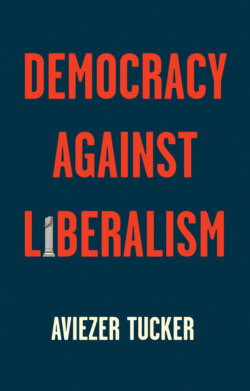Читать книгу Democracy Against Liberalism - Aviezer Tucker - Страница 7
Liberalism vs. Absolutism
ОглавлениеI use liberalism as a constitutional institutional and social structure that checks and limits the size, scope, and reach of government. Liberalism can co-exist with democratic, authoritarian, and other regimes, but not with totalitarianism that can accept no institutional or legal limits. In modern societies, liberalism is manifest in the rule of law enforced by independent branches of government, such as the judiciary. Some of these institutions guarantee rights. Without institutions, rights are ideals and ideologies, not political reality, “nonsense upon stilts” as Jeremy Bentham put it. Absolutism is the opposite of liberalism. It eschews checks or balances on the scope, size, or power of government. Absolutism can be authoritarian as well as democratic.
Liberalism developed originally to submit monarchs to laws that codified traditional and not so traditional rights, as interpreted by independent judges. Absolutist governments could and did grant privileges and sufferance to minorities and civil society, but they could rescind them at will. The universality of the rule of law protected the rights of minorities and the autonomy of civil society. The state’s size, powers, and capacities grew with the expansion and professionalization of state bureaucracy and following technological advances. It has become necessary, then, to increase the number and strength of liberal institutions to preserve the balance between the powers of the state and society. The division between the three branches of government became insufficient. Other independent institutions accumulated, including institutional religion, the free and independent media, the education system, and the Central Bank. These institutions may be financed by the government as long as they maintain their independence. The modern liberal state is further bound by a web of international treaties and agreements that are adjudicated and implemented by international liberal institutions such as the World Bank, the International Monetary Fund, the International Trade Agreement, and the European Union.
The liberal to absolutist dimension is continuous. Even absolute monarchies were not entirely unencumbered by institutions. When the French monarchy needed to increase taxation, it had to call the estates, thereby triggering the French Revolution. The independence of central banks is historically recent and resulted from the populist temptation of democratic governments to push interest rates too low for too long and generate hyper-inflation. Other institutions, like the political party, may limit the power of government by forcing it to use the party’s mediation to connect with supporters. Absolutist governments prefer unmediated personalized relationships with unorganized and unstructured followers. Successful ancient demagogues, tribunes of the plebs, and dictators had such a direct relation with masses and mobs.
Absolutism describes better the opposite pole to liberalism than illiberalism because it has been in use and debated for centuries. However, in the contemporary political context, illiberalism has become the entrenched dominant term in use, at least since Fareed Zakaria (2003) popularized the term “illiberal democracy,” and Hungary’s prime minister Viktor Orbán dusted it off for his own needs. In this book I use illiberalism and absolutism interchangeably. I use neo-illiberalism, the main topic of this book, in contemporary contexts, and absolutism when writing about history, to emphasize that this is a new incarnation of an old type of regime.
